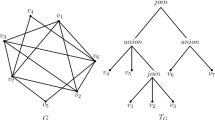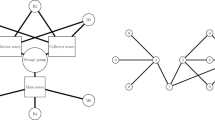Abstract
A function \(f:V(G)\rightarrow \{0,1,2\}\) is a Roman dominating function (RDF) if every vertex u for which \(f(u)=0\) is adjacent to at least one vertex v for which \(f(v)=2\). The weight of a Roman dominating function is the value \(f(V(G))=\sum _{u \in V}f(u)\). The Roman domination number of a graph G, denoted by \(\gamma _{R}(G)\), is the minimum weight of a Roman dominating function on G. A connected (respectively, total) Roman dominating function is an RDF f such that the vertices with non-zero labels under f induce a connected graph (respectively, a subgraph with no isolated vertex). The connected (respectively, total) Roman domination number of a graph G, denoted by \(\gamma _{cR}(G)\) (respectively, \(\gamma _{tR}(G)\)) is the minimum weight of a connected (respectively, total) RDF of G. It this paper we first study the complexity issue of the problems posed in [H. Abdollahzadeh Ahangar, M. A. Henning, V. Samodivkin and I. G. Yero, Total Roman domination in graphs, Appl. Anal. Discret. Math. 10 (2016), 501–517], and show that the problem of deciding whether \(\gamma _{tR}(G)=2\gamma (G)\), \(\gamma _{tR}(G)=2\gamma _t(G)\) or \(\gamma _{tR}(G)=3\gamma (G)\) is NP-hard even when restricted to chordal or bipartite graphs. Then, we give a linear algorithm that decides whether \(\gamma _{tR}(G)=2\gamma (G)\), \(\gamma _{tR}(G)=2\gamma _t(G)\) or \(\gamma _{tR}(G)=3\gamma (G)\), if G is a tree or a unicyclic graph.






Similar content being viewed by others
References
Abdollahzadeh Ahangar H, Henning MA, Samodivkin V, Yero IG (2016) Total Roman domination in graphs. Appl Anal Discrete Math 10:501–517
Abdollahzadeh Ahangar H, Chellali M, Kuziak D, Samodivkin V (2016) On maximal Roman domination in graphs. Int J Comput Math 93(7):1093–1102
Amjadi J, Sheikholeslami SM, Soroudi M (2018) Nordhaus–Gaddum bounds for total Roman domination. J Comb Optim 35:126–133
Amjadi J, Sheikholeslami SM, Soroudi M (2019) On the total Roman domination in trees. Discuss Math Graph Theory 39:519–532
Amjadi J, Nazari-Moghaddam S, Sheikholeslam SM, Volkmann L (2017) Total Roman domination number of trees. Australas J Combin 69(2):271–285
Campanelli N, Kuziak D (2019) Total Roman domination in the lexicographic product of graphs. Discrete Appl Math 263:88–95
Chellali M, Haynes TW, Hedetniemi ST, MacRae A (2016) Roman \(\{2\}\)-domination. Discrete Appl Math 204:22–28
Cockayane EJ, Dreyer PM Jr, Hedetniemi SM, Hedetniemi ST (2004) On Roman domination in graphs. Discrete Math 278:11–22
Cockayne EJ, Goodman S, Hedetniemi S (1975) A linear algorithm for the domination number of a tree. Inf Process Lett 4(2):41–44
Garey MR, Johnson DS (1979) Computers and intractability: a guide to the theory of NP-Completeness. W. H. Freeman, New York
Haynes TW, Hedetniemi ST, Slater PJ (1998) Fundamentals of domination in graphs. Marcel Dekker, Inc., New York
Laskar R, Pfaff J, Hedetniemi SM, Hedetniemi ST (1984) On the algorithmic complexity of total domination. SIAM J. Algebr Discrete Methods 5(3):420–425
Li M (2016) On the \(k\)-Roman domination of graphs. J Comput Theory Nanosci 13:2705–2709
Liu C-H, Chang GJ (2013) Roman domination on strongly chordal graphs. J Comb Optim 26:608–619
Rahmouni A, Chellali M (2018) Independent Roman \(\{2\}\)-domination in graphs. Discrete Appl Math 236:408–414
Revelle CS, Rosing KE (2000) Defendens imperium romanum: a classical problem in military strategy. Am Math Mon 107:585–594
Stewart I (1999) Defend the roman empire!. Sci Am 281(6):136–139
Author information
Authors and Affiliations
Corresponding author
Additional information
Publisher's Note
Springer Nature remains neutral with regard to jurisdictional claims in published maps and institutional affiliations.
Rights and permissions
About this article
Cite this article
Poureidi, A., Rad, N.J. Algorithmic and complexity aspects of problems related to total Roman domination for graphs. J Comb Optim 39, 747–763 (2020). https://doi.org/10.1007/s10878-019-00514-x
Published:
Issue Date:
DOI: https://doi.org/10.1007/s10878-019-00514-x




